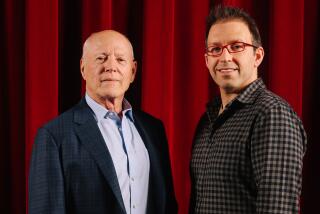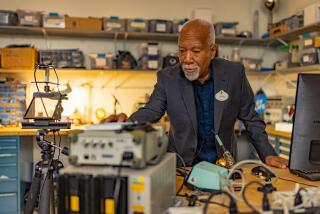Therapy for Some Patients Works Like . . . Well--Magic
- Share via
INGLEWOOD — Every Tuesday evening, Tim Holly does his magic act with some special partners--hospital patients who are struggling to come back from devastating head and spinal injuries or strokes that have impaired their limbs, speech and, sometimes, their thinking.
Little red balls and coins that vanish, dice thrown onto a felt tray, and ropes tied in seemingly impossible knots are Holly’s props as he guides patients at Daniel Freeman Memorial Hospital here through a variety of tricks and games designed to get hands and arms working again and to unmuddle muddled minds.
“There’s no motivation factor in traditional therapy,” said Holly, which he likened to “sitting around the therapy department squeezing a ball.”
But, he said, “magic gives you an incentive to try and forget that a limb doesn’t move and just try to see if it does.”
Holly should know. He used magic on himself to regain use of his arms after they were injured a few years ago when he was a Marine.
Builds Self-Esteem
Recreational therapist Marla Edelman said one of the values of magic is building self-esteem in patients whose recoveries often are achingly slow and fraught with frustration: “We want them to do something that is fun and successful. It helps being able to show a trick to someone else, being able to entertain.”
Holly, who does magic as a hobby and earns his living managing a motion picture and television sound company in Hollywood, has been coming to Daniel Freeman weekly for a 1 1/2 years as a part of David Copperfield’s Project Magic, a network of magicians who go voluntarily into hospitals and work with occupational therapists to help patients.
The project was started in 1982 by magician David Copperfield after he received a letter from a young man who was building a career as a magician despite being in a wheelchair. Copperfield realized that magic is a way to reach the disabled and he went on to develop a manual of tricks--designed to achieve specific therapeutic goals--and to conduct workshops for physical and occupational therapists.
Headquartered at Daniel Freeman, Project Magic is being used in such hospitals as St. Jude in Fullerton and Glendale Adventist. Long Beach Memorial, which had a program two years ago, is planning to start it again.
Months of Work
For Holly, Tuesday night successes with Daniel Freeman patients often evolve during months of work and no small amount of frustration in demonstrating and performing tricks. He usually works with three or four patients each week.
“The patients get frustrated because it’s something they want to learn and I get frustrated because I know they can do it,” he said.
He recalled Randy, a young man with a severe head injury and impaired memory: “I spent six weeks teaching him to tie a knot in a rope that I thought would be a very simple rope trick.”
Holly said he has had some success with most patients, although some with severe head traumas have been marginal: “I can get through bad temperaments, but if their attention span is too short, it’s very taxing to work with them. Some are too limited and they have to recover more.”
One of his current successes in progress is 15-year-old Alan Yonai of West Los Angeles, a spunky youngster with a shock of black hair who has not walked, or talked very much, for nearly a year. He suffered severe head injuries and brain damage and leg and arm fractures after a car he was riding in went off the freeway near the small desert town of Baker.
‘A Miracle’
“He was not expected to live,” said his mother, Susan Carrasco. “He was worse than dead. He’s come a long, long way. It’s really a miracle.”
Alan’s brain damage affects his motor control and speech but not his mental faculties, and Edelman said the magic tricks Holly is teaching him are intended to increase the use of his upper body, arms and hands, and to encourage his speech.
“When he performs the tricks, he has to give verbal explanations,” she said.
Said Holly, “Alan’s mind is really, really sharp so I could teach him a mental type of magic.”
One of the first games they played was a dice throw, in which Alan says--in a weak, somewhat indistinct voice--how many dots are on the side facing downward on the tray.
He’s never wrong.
The other evening, the dice were rolled and Holly asked how many dots were the concealed side.
“Four,” Alan said.
“Talk louder,” Holly responded.
“FOUR!”
“He couldn’t open or close his hands when we started,” Holly said. “The trick helps him with hand movements, sequencing, memory and problem solving.”
Favorite Trick
The dice roll, using one or two dice, is Alan’s favorite trick. Why? “Easy” is the word he spelled out, pointing to individual letters on an alphabet board he uses to communicate when speech is too difficult.
Lately, the two have been working on the “rubber pencil trick” for finger dexterity. Flick it up and down fast enough, and the solid wooden pencil appears to undulate like rubber. It is used to help Alan regain use of fingers that have limited movement now.
They are also using the “French vanish,” another trick that allows Alan to use his fingers. During Holly’s visit last week, Alan made a little red ball “disappear” and then, by moving a seemingly empty cup up and down, made it “magically” fall onto his blanket. Then, Holly took Alan’s hands in his and helped him manipulate the little red ball, rolling it from side to side.
As if to say, “I’ve done my part,” Alan asked Holly to do the trick, and the magician proceeded to move the ball lightly in his hands until it vanished and then slyly plucked it from his back pocket.
“That’s what I want you to work on,” he said to Alan.
Began at 5
Holly, who is 26 and lives in Van Nuys, was 5 years old when he became obsessed with magic and began devising his own tricks. “That’s what you do when you grow up in Ohio without any magicians,” he said.
He joined the Marine Corps at 17 and during a training exercise at Camp Pendleton in 1978 he lost partial use of both arms.
“We were doing ‘rescue the ambassador from the terrorists’ and I was with the assault squad,” Holly recalled. “I jumped over a rain ditch and landed on the other side, but my backpack and equipment kept going, my arms rotated forward, and I tore up both shoulder blades.”
Though he still had a grip, Holly could move his arms only at the elbows. He said he was determined to do coin and card tricks again so he began working to regain hand and arm coordination. In the process, he found some other injured men who were interested in magic as therapy.
Later, Holly heard about David Copperfield’s Project Magic, contacted him and, while still in the Marines, began doing magic on a regular basis at San Diego Children’s Hospital.
He’s been at it ever since, moving his act to Daniel Freeman after leaving the Marines.
“I like seeing the patients’ eyes light up when they do a trick,” he said.
“No one has ever asked me not to come back.”
More to Read
Sign up for Essential California
The most important California stories and recommendations in your inbox every morning.
You may occasionally receive promotional content from the Los Angeles Times.










